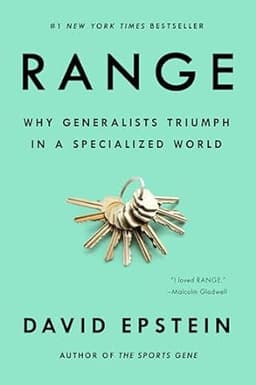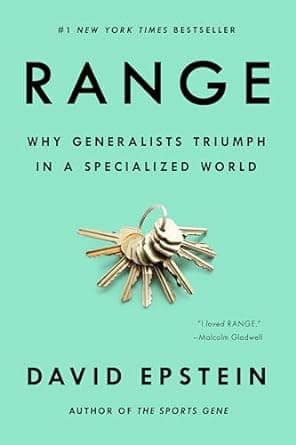
A Mind For Numbers Book Summary
How to Excel at Math and Science
Book by Barbara Oakley
Summary
"A Mind for Numbers" by Barbara Oakley reveals the science-backed techniques and insights that can transform anyone's ability to excel in math, science and complex subjects by harnessing the brain's innate learning abilities.
Sign in to rate
Average Rating: 4.67
Two Modes Of Thinking: Focused And Diffuse
Our brain has two different modes of thinking: focused mode and diffuse mode. Focused mode involves concentrating intently on something, like a flashlight beam, while diffuse mode is more relaxed, allowing you to look at things broadly from different angles. Both modes are important for learning. Focused mode is essential for absorbing information by paying full attention. Diffuse mode allows your brain to subconsciously process what you've learned and make new creative connections. You can't be in both modes at the same time - it's like a pinball machine where the bumpers are close together for focused mode and spread apart for diffuse mode.
Section: 1, Chapter: 1
Procrastination Arises From Pain Centers In The Brain
When you think about something you don't like, such as a difficult math problem, the pain centers in your brain light up. This leads you to shift your attention to something more pleasant, like checking social media, causing you to procrastinate. Procrastination shares similarities with addiction, giving temporary relief but leading to worse outcomes in the long run. Pomodoro technique - focusing for 25 minutes then rewarding yourself - can help overcome procrastination.
Section: 1, Chapter: 1
Shifting Between Focused And Diffuse Modes
To make the most of both focused and diffuse modes:
- First do focused mode work by paying full attention and grappling directly with the concepts
- Then do something to get into diffuse mode - go for a walk, take a shower, listen to music, sleep. Let your subconscious work in the background.
- Return later to focused mode - the diffuse insights you gained will often help you make progress
- Continue alternating between focused and diffuse to build solid conceptual understanding over time
The key is not to get stuck in one mode, especially focused. Frustration is often a sign you need to switch modes.
Section: 1, Chapter: 2
Thinking in Diffuse Mode
"But as long as we are consciously focusing on a problem, we are blocking the diffuse mode."
Section: 1, Chapter: 1
Slow Hunches Lead To Breakthroughs
Great ideas often arise not in a single "eureka!" moment but through "slow hunches" over a long period of time. Author Steven Johnson gives examples like Darwin's theory of evolution and the creation of the World Wide Web. Key ideas simmered in the creators' minds, sometimes for years, with diffuse mode slowly making connections until the full concepts took shape. Focused mode dives deep into a subject, building solid chunks of understanding. Diffuse mode, through long solitary walks or other relaxing activities, allows those chunks to slowly connect together in new ways over time, leading to major creative breakthroughs.
Section: 1, Chapter: 2
This concept is also discussed in:
Where Good Ideas Come From
Three Steps To Forming Conceptual Chunks
Chunks are compact packages of information bound together through use and meaning. They are the building blocks of expertise in math, science, and other subjects. To form a chunk:
- Focus intensely on the information you want to chunk, bringing it into working memory
- Understand the basic idea you are trying to chunk - the gist of the concept. Understanding is like a superglue that binds the memory links together.
- Gain context so you see not just how to use the chunk, but when to use it. Do this by practicing with different problem types so you see when to apply the chunk.
Section: 1, Chapter: 4
Recall Beats Passive Rereading
Simply rereading text or staring at notes is not an effective way to study and can lead to illusions of competence. A far more powerful technique is recall - looking away and seeing what you can retrieve from memory. After reading a page, close the book and recall the key ideas. If you can't, reread.
But always push yourself to recall. The effortful act of retrieving knowledge builds long-term memory and understanding. It's like building hooks to hang your thinking on. Recalling in different environments than where you originally learned also helps strengthen and internalize the material.
Section: 1, Chapter: 4
Active Recall
"A good rule of thumb, when you are first learning new concepts, is not to let things go untouched for longer than a day."
Section: 1, Chapter: 3
"I have not failed. I've just found 10,000 ways that won't work."
Thomas Edison, one of the most prolific inventors in history, had this perspective about failure and persistence. When his attempts didn't work, he didn't see them as failures but as successful discoveries of ineffective approaches. This allowed him to keep inventing and making progress where others may have quit. In math and science, mistakes are inevitable and provide valuable learning opportunities. Embrace them as part of the learning process, and keep a positive attitude even when the going gets tough.
Section: 1, Chapter: 3
Habits Are Like Zombie Programs In Your Brain
Habits are neurological cravings that automatically trigger behaviors without conscious thought - like zombies in your brain. They have four parts:
- the cue (the trigger for the zombie mode),
- the routine (the zombie response itself),
- the reward (the pleasure you get from it),
- and the belief (your underlying belief that powers the habit).
To change a habit, you must address each part, especially the cue and reward. Procrastination is a habit that arises from cues like seeing a challenging math problem. This triggers the routine of avoiding it for something more pleasant. The reward is temporary relief, and the underlying belief is that math is unpleasant. By identifying cues, changing routines and rewards, and shifting beliefs, you can reprogram your zombie habits.
Section: 1, Chapter: 6
Focus On Process, Not Product To Prevent Procrastination
When facing a daunting task like a challenging homework assignment, don't focus on completing the entire product, which can feel overwhelming. Instead, focus on the process - just putting in a certain number of focused minutes or hours on it. Set a Pomodoro timer for 25 minutes and work with focused intensity for that time.
The key is to avoid judging yourself or worrying about completing the final product. Just focus on putting in the time with good process. Paradoxically, this "product-less" process focus actually leads to completing more products over time. Procrastination is often caused by product anxiety. Process focus helps avoid that cue.
Section: 1, Chapter: 6
Willpower Is A Limited Resource
Relying heavily on willpower to beat procrastination is an uphill battle. Research shows that willpower is a limited resource that depletes quickly. It uses a lot of neural resources and energy. Tackling procrastination head-on with willpower alone is like trying to smash through a brick wall. A better approach is to use habits and systems to work around procrastination rather than powering through it. Build schedules, routines, and productive habits that make procrastination less likely. When you do need bursts of willpower, make sure you are well rested and fed. But don't rely on it as your only tool.
Section: 1, Chapter: 6
This concept is also discussed in:
Atomic Habits
Memorizing Helps Internalize Concepts
Memorizing gets a bad rap in learning. But the key is to memorize material you already understand. Doing this helps internalize the core concepts more deeply and frees up mental energy to connect ideas in new ways. Memory techniques like mnemonics, visualization, and memory palaces make memorizing more fun and effective. The more you memorize foundational concepts, the easier it is to assimilate new ones. The key is to memorize after understanding, not just blind rote learning. Memorizing is a powerful tool for internalizing core concepts.
Section: 1, Chapter: 7
Create Vivid Visual Metaphors And Analogies
One of the best ways to understand and internalize math and science concepts is to create visual metaphors and analogies for them. Metaphors and analogies activate visual areas of your brain and help you understand abstract ideas more tangibly.
For example, you might visualize multiplying exponents by thinking of a stack of poker chips. If each poker chip represented 10, then 3 poker chips is 103 or 1000. Stacking those on top of 2 more chips is 103 * 102, or 100,000. The stack of 5 chips represents the product. Coming up with vivid metaphors engages more of your senses and makes abstract concepts memorable.
Section: 1, Chapter: 7
This concept is also discussed in:
Moonwalking with Einstein
Human Approach to Teaching Math and Science
"What a wonderful stimulant it would be for the beginner if his instructor, instead of amazing and dismaying him with the sublimity of great past achievements, would reveal instead the origin of each scientific discovery, the series of errors and missteps that preceded it—information that, from a human perspective, is essential to an accurate explanation of the discovery." - Santiago Ramon y Cajal
Section: 1, Chapter: 8
Transform Distant Deadlines Into Daily Ones
One effective way to combat procrastination on big projects is to break them down into smaller daily tasks and deadlines. Set a goal to work on the project a little bit each day, rather than waiting until right before it's due to get started. This makes the project feel more manageable and helps build momentum over time.
Use tools like a daily planner or to-do list to schedule in regular work sessions and make the daily tasks feel as important as the final deadline.
Section: 1, Chapter: 9
How Focusing Your Attention Changes Your Brain's Wiring
When you focus your attention on learning something, you initiate a process of building and strengthening neural connections in your brain related to that skill or knowledge. The more you focus on it, the stronger those neural pathways become.
This process, called neuroplasticity, means your brain physically changes shape based on what you pay attention to and practice. The key is to concentrate deeply and practice consistently over time. Even skills that feel challenging and foreign at first can become second nature with the right kind of focused practice.
However, the opposite is also true. When you procrastinate or distract yourself from focusing on something, those neural pathways related to it weaken over time. In this way, where you focus your attention literally shapes the physical wiring of your mind.
Section: 1, Chapter: 13
Don't Be Afraid To Combine Your Interests
Many influential figures throughout history achieved great insights and innovations by combining seemingly unrelated fields in novel ways:
- Santiago Ramón y Cajal applied his artistic talents to produce stunningly detailed drawings of microscopic brain cells, revolutionizing neuroscience.
- Nobel-prize winning physicist Richard Feynman credited his insights to his habit of jumping between different fields and problems.
- Steve Jobs famously combined his interests in calligraphy, meditation, and technology to make Apple products that stood out.
The lesson is to embrace your multifaceted interests and background, even if they seem contradictory at first glance. Having broad influences allows you to approach problems in unique ways and make creative leaps that more rigid thinkers miss.
Section: 1, Chapter: 13
This concept is also discussed in:
Range
Retrieve Information From Memory
One of the most effective ways to cement new knowledge in your long-term memory is to practice retrieving it from memory, rather than just passively rereading it. The act of retrieving information from memory strengthens the neural pathways associated with that knowledge, making it easier to recall in the future. It also reveals gaps in your memory and understanding.
Some effective methods of retrieval practice include:
- Flashcards - put a question or prompt on one side and the answer on the back. Quiz yourself and check the answer.
- Summarizing - after reading a section or chapter, close the book and summarize the key ideas in your own words. Check your summary against the text.
- Self-testing - use practice problems or old exam questions to test your ability to apply what you've learned. Check your answers afterward.
Space out your self-quizzing over time for maximum retention. And don't just stick to easy questions - retrieval is most effective when it's appropriately challenging.
Section: 1, Chapter: 11
The Role Of The Right Brain In Learning And Insight
While the left hemisphere of the brain is associated with logical, sequential thinking, the right hemisphere plays a key role in generating insights and seeing the big picture. The right brain helps us:
- Get an intuitive overview of a concept or problem
- Make connections between seemingly unrelated ideas
- Engage in creative, non-linear thinking
The left brain is adept at carrying out learned procedures, but it can get stuck in a rut or miss the forest for the trees. The right brain acts as a "fact checker" to catch errors and generate novel approaches.
Engaging both sides of the brain is key to effective learning and problem-solving. After focusing intently on solving a problem (left brain), it helps to let your mind wander and look at it from a different angle (right brain). Sleep also seems to facilitate communication between the hemispheres, allowing the right brain to find hidden patterns and insights.
Section: 1, Chapter: 16
Related Content


Range Book Summary
David Epstein
"Range" challenges the conventional wisdom that early specialization is the key to success. Instead, Epstein argues that in our increasingly complex and unpredictable world, it is those with broad experience and diverse skills who are best equipped to thrive.
"Range" challenges the conventional wisdom that early specialization is the key to success. Instead, Epstein argues that in our increasingly complex and unpredictable world, it is those with broad experience and diverse skills who are best equipped to thrive.
Personal Development
Learning
Psychology

